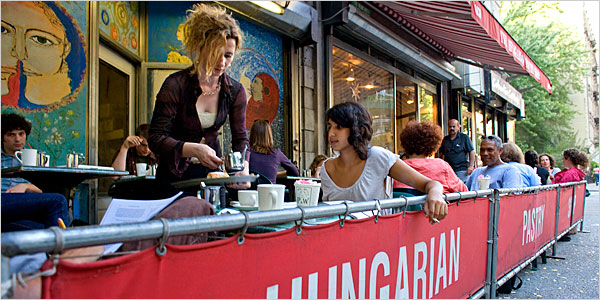Ivy League by Uptown Train
Weekend in New York | Columbia University
By SETH KUGEL October 7, 2007
The Hungarian Pastry Shop, a longtime local hangout.
IT'S easy to forget that Manhattan is a college town, probably because it is also a theater town, a finance town, a fashion town, a museum town, a restaurant town and a “who has time for restaurants, let's just get a slice of pizza” town.
But the island is also crawling with students and professors, and not just downtown around New York University. Everyone from regular tourists to parents and teenagers on college tours to the Iranian president, Mahmoud Ahmadinejad, seems to make a point of heading up to Morningside Heights to visit Columbia University, New York's very own Ivy League institution.
And though it's a hike (or a 20-minute ride on the No. 1 train) from Midtown hotels, the campus does what campuses everywhere do: attracts controversial speakers, great concerts, fine art, spunky restaurants and more cafes than you can shake a stirrer at. The campus itself, the closest Manhattan comes to bucolic academia, is a pleasure to walk through, especially since the city transferred the title of 116th Street between Broadway and Amsterdam to Columbia on Aug. 15, 1953, creating a huge quad. (If you haven't visited since then, you're definitely past due.)
There are free tours of the campus weekdays, but it is pretty hard to get lost if you want to do it on your own on a weekend: wander through the quad and weave through the academic and student life buildings on either side, check out the squat but handsome early-20th-century St. Paul's Chapel (with netting conveniently installed in the dome above to prevent you from getting beaned by a falling brick) and the eclectic Wallach Art Gallery, currently featuring an exhibition of Makonde art from Mozambique. The campus is full of lawns and places to sit and outdoor sculptures like a cast of Rodin's “Thinker” outside Philosophy Hall. Careful observers will note a distinct difference between the statue's posture and that of the typical student, more likely to be posing nearby as the Flirter or the Sunbather.
There are even a few worthy tourist attractions off campus, aside from the much-photographed Tom's Restaurant, the outside of which became famous as the “Seinfeld” diner where Jerry, George, Elaine and Kramer planned contests and ordered “big salads.” Grant's Tomb, a national monument run by the National Parks Service (with Riverside Church across Riverside Drive), is not far, and the Gothic-Romanesque Cathedral Church of St. John the Divine, though still recovering from a 2001 fire, is awe-inspiring.
You'll want to pair your visit at St. John's with a stop at the almost-as-historic Hungarian Pastry Shop, known not so much for pastries as for its atmosphere of academic caffeination. If not for a proliferation of Macintoshes, it would seem a college scene from decades past: students with unkempt hair, mediocre complexions and fantastic metabolisms diving into creamy cakes with much enthusiasm and reading Homer with slightly less.
Though snooty foodies may condemn Morningside Heights' restaurant scene as a wasteland, you can at the very least eat well for a weekend, and more so now with the recent addition of China de Puebla. In July, Marian Burros, writing in The Times, praised it for its “fresh, carefully prepared combinations of Mexican and Asian ingredients that are a delightful surprise in a casual neighborhood restaurant.”
On Amsterdam, Max SoHa serves Italian food whose entree prices won't have you fleeing for the pasta section. Its cousin Max Caffé is on the same block, and between them is the brunch spot Kitchenette with its pinkish (but not in a bad way) interior.
It's no Village, but there are a number of stores that befit a campus area, like Kim's Video and Music, where foreign-film buffs will celebrate the relegation of the domestic industry to the “American” section. There is a small music section as well, for the .001 percent of college students who still buy CDs. Hidden on a side street, bookculture — the former Labyrinth Books — is Ivy League intellectual enough that the two most prominently displayed periodicals on a recent visit were Der Spiegel and The New York Review of Books.
You'll find more jumping neighborhoods elsewhere in the city, though there are plenty of arts events at places like the Miller Theater listed at calendar.columbia.edu. One thing you won't find anywhere else is the Postcrypt Coffeehouse, a musty hideaway tucked into the depths of the St. Paul's basement where singers from the accomplished to the totally disastrous perform Friday and Saturday nights. The tiny spot serves $1 coffee so awful they should refund your dollar if you finish it, but makes up for it with free popcorn.
And there are plenty of bars, although the old Jack Kerouac hangout the West End recently became an odd college-bar-and-Cuban-restaurant hybrid, Havana Central at the West End. If the night-life offerings aren't cutting it, there's always that neighborhood just to the north: Harlem. (And don't forget the big city to the south.)
VISITOR INFORMATION
Columbia University campus tours open to all leave from the visitors center, Low Memorial Library, Room 213, at 1 p.m. weekdays.
Grant's Tomb (General Grant National Memorial), Riverside Drive at 122nd Street; (212) 666-1640.
Cathedral Church of St. John the Divine, 1047 Amsterdam Avenue, at 112th Street; (212) 316-7540.
Hungarian Pastry Shop, 1030 Amsterdam Avenue, between 110th and 111th Streets; (212) 866-4230.
China de Puebla, 3143 Broadway, two blocks south of 125th Street; (212) 222-8666.
Max SoHa, 1274 Amsterdam Avenue, at 123rd Street; (212) 531-2221.
Kitchenette, 1272 Amsterdam, between 122nd and 123rd Streets; (212) 531-7600.
Kim's Video and Music, 2906 Broadway, between 113th and 114th Streets; (212) 864-5321.
bookculture, 536 West 112th Street; (212) 865-1588.
Postcrypt Coffee House, in the basement of St. Paul's Chapel at Columbia.
Havana Central at the West End, 2911 Broadway, between 113th and 114th Streets; (212) 662-8830.
